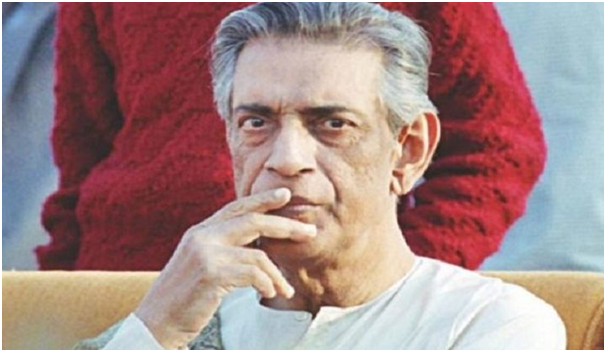RAY'S INSIGHT INTO THE CHILD'S MIND
Just close your eyes and think of Apu and Durga running through the kaash fields in Pather Panchali to see the train; a slightly grown-up Apu in Aparajito giving an oil massage to his mother’s employer; the little Kajol asking his father whether he is a friend in Apur Sansar; the proud little orphan girl Ratan who refuses the one-rupee tip from her master in Postmaster; the exquisitely beautiful and tomboyish Mrinmoyee in Samapti who does not care about her favourite squirrel’s death because she is now a grown woman; the child and teenage protagonists in his Feluda series of mystery films; the innocent little boy who asks his mother how to use white for a flower in a painting about his garden in Pikoo; the naïve grandson who asks his ailing grandfather what ‘do numberi money’ means in Shakha Proshakha; and the quiet little docile boy of Agantuk who is the only member of the family to place complete faith in the stranger who has arrived from nowhere.
These are children created and nurtured by Ray through the magic of his imagination, his aesthetics and his humane sensibilities. They are children who transcend the synthetic boundaries of celluloid and the framed confines of the screen to step into our hearts and remain there forever. This understanding of the child’s mindset, this ability to look at the world through the eyes of the child, was within Ray’s genes. His grandfather Upendrakishore Roychoudhury and his father Sukumar Roy were gifted creators of literature for children. Their works are still regarded as milestones in the history of children’s literature in Bengali.
Ray was practically sucked into the world of the child when he began to illustrate books like Pagla Dashu, Haw-Jaw-Baw-Raw-Law-the famous book of nonsense rhymes authored by his father. Later, the involvement deepened with the revival of the then-extinct children’s magazine Sandesh, founded, edited and published by grandfather Upendrakishore. Ray edited and illustrated the revived Sandesh jointly with Leela Majumdar till his death. Ray’s contribution to children’s literature is comprised of 21 novels and 11 short story compilations, most of them translated in many languages across the world. The two incredible and immortal characters Ray has gifted his child-readers with are – Feluda and Professor Shanku. Feluda later turned into a celluloid character that has now cut across the barrier of time and creation with Bombaiyer Bombete directed by Ray’s son Sandip.
Utpalendu Chakraborty, a director who won acclaim with films like Chokh and Debshishu, made an interesting 77-minute documentary Child Artistes and Satyajit Ray. Produced under the banner of Human Art Centre, the film was Censor-certified in 1997 but was never released. This is the only that explores the mastery of Satyajit Ray over children not only in terms of presenting them as characters within a film, but also through stories written specifically with the child-reader and child-viewer in mind. Ray had the rare ability of handling them in a way that made them appear as if they had been picked out of real life. From Pather Panchali to Agantuk, Ray tackled children as children. Yet, he took them out of their urban, educated, modern backdrop to place them in a rural setting as and when the script demanded. Not once did they appear out of place. Not once did they once behave or speak like adults do.
Pikoo, a short film made originally for French TV based on Ray’s own story, is not a film for children but it helps adults to look at their world through the eyes of the child. Goopy Gyne Bagha Byne and Hirak Rajar Deshe were films targeted at a universal audience. Children enjoyed these films for the fantasy, the music, the fairy-tale element and the magic while adults could read in them, thinly veiled attacks against the politics of totalitarianism and suppression of individual freedom.
Kushal Chakravorty who played the main role of the kidnapped boy in Ray’s Sonar Kella, now a well-known television hero, laughingly says he was too little to understand who Ray was and why he was considered such a larger-than-life personality. "His gift lay in that that he never treated us like children. I would play chess with him between shoots and I would win every time. Maybe, he allowed me to win. I was surprised to find my father in constant awe of him. This treatment of placing children on an equal platform helped us open up. All we had to do was to act ourselves to be natural. In the given ambience, as far as I can remember, I don't think it was difficult," recalls Kushal.
Siddhartha Chatterjee who played Feluda’s teenage assistant in Sonar Kella maintained a diary during the shooting. “The three facets of Ray's persona I found to be the most fascinating are (a) his total control over any situation related directly or indirectly to his work, (b) his ability to take speedy and instantaneous decisions and (c) time management. In fact, my Topshe character has carried over to my daughter's school. When she bagged the first prize at the fancy dress contest, her teachers asked her where she had honed her acting skills from. Her prompt response was, "why, from my father. Don't you know that he is the Topshe from all the Felu-da films?" That is the impact of Ray and his Felu-da."
The high point of Gautam Ghose’s documentary on the great master simply titled Ray (2001) is the intrigue it triggers off by shedding light again and again on a sentence Ray often marked his beautiful scripts with. “I don’t know.” These three words occur time and again, sometimes in the margin, at other times, right into the script, or below a dialogue, raising questions about a sense of uncertainty that seems to have dogged Ray along his journey towards greatness.





